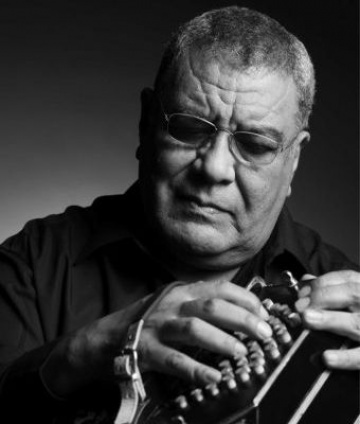About artist
Timoteo "Dino" Saluzzi was born in 1935 in Campo Santo, Salta Province, Argentina, a small village in the northwest of Argentinanoted primarily for its sugar cane refining factory, around which local life revolved. Despite the absence of records, radio and indeed electricity in the Saluzzi household there was always music. His father played guitar, mandolin and bandoneon and taught Dino the rudiments of the latter instrument at seven. On this popular German import, the diatonic variety of the accordion developed by Heinrich Band, the young Saluzzi at first played folk music.
An uncle who had traveled in Europe added some of his acquired musical knowledge and, by the time he was 14, Dino knew enough to play in the Trio Carnaval, his first band. He began to play professionally while studying in Buenos Aires and was soon a member of the symphonic Orquesta Estable at Radio El Mundo, Argentinia's first radio station. It was in Buenos Aires, too, that he met Astor Piazzolla, as the term "tango nuevo" began to be aired. Though Astor Piazzolla and Saluzzi always respected each other's work, Dino has never cared to put a lable on his own music. In numerous interviews, however, he has stressed that it is neither an "art music" nor an "intellectual music" but rather a music of the emotions and one that attemps to express the widest range of feelings.
Quitting his radio orchestra job in 1956, Saluzzi returned to Salta Province to develop his compositions, now consciously incorporating folk music elements. From this point onward, however, he was concerned that his music would not "fall into the common eclecticism" that had already deluted several variants of Latin American music. He sought a flexible form that was "vital and real beyond the conventions": this has proved to be a life's work. In the early 70s Dino was briefly associated with Gato Barbieri, helping the saxophonist towards a rediscovery of his own roots on, for example, the album Chapter One: Latin America. With Mariano Mores he undertook numerous South American tours, playing concerts in Bolivia, Peru, Columbia and Venezuela. He also worked as arranger and soloist for Enrique Mario Francini's Sinfonica de Tango which brought him to Japan in 1977. In 1979 he launched the first Cuarteto Dino Saluzzi, whose early European appearances made headlines, and also co-founded the experimental chamber ensemble Música Creativa.
Saluzzi's ECM discography was launched with the solo album Kultrum, spontaneously created in the studio and an enduring example of the bandoneonist's art as "storyteller." Dino described the music as "an imaginary return" to the little towns and villages of his childhood. The vividness of his musical sketches was not lost on reviewers: "Reworking elements of tango, South American Indian music, backwater folk tunes, and other root sounds, his breadth of feeling makes for remarkable listening" - Down Beat. A second solo album Andina, prompted America's Fanfare to write that "Dino Saluzzi is probably the greatest living master of the bandoneon", concluding that the recording was "a stunning portrait of an amazing musical talent."
American jazz musicians; many bandleaders were keen to provide a setting for Saluzzi's bandoneon. ECM brought Saluzzi together with Charlie Haden, Palle Mikkelborg and Pierre Favre for Once Upon A Time ... Far Away In The South, and subsequently with Enrico Rava for Volver. Rava had worked extensively in Argentina, and Haden's sympathy for Latin American music was well-known; furthermore Mikkleborg and Saluzzi had worked together productively in George Gruntz's band: there was a common ground on which an artistic exchange of ideas could take place. Saluzzi later played with Haden's Liberation Music Orchestra, and the Rava Saluzzi Quintet also toured.
Liberation Music Orchestra, and the Rava Saluzzi Quintet also toured. Dino Saluzzi has, additionally, performed with Louis Sclavis, Edward Vesala, Charlie Mariano, Al DiMeola, David Friedman, Anthony Cox and many others, inevitably able to maintain his own, strong identity in each context. "I try not to have any preconceptions of what music should be like", he told Down Beat. "I'm not afraid of anything I create because I know it will be a refelection of myself and my culture. If I play jazz, I play jazz. It's just a different way of expressing my feelings." But he also noted elsewhere that "the tango is more complex than most jazz. In the real tango, which is kind of loose and permits free interpretation, it is not enough to know the technical parts - the chords, scales et cetera. It need a tontally different expression. It is something both much purer and more complicated."
In 1991, Saluzzi was able to realize a long-held ambition: making an ECM album in Argentina together with his brothers Felix and Celso and his son José. Mojotoro drew upon the full range of South American musics: tango, folk, candina music, candombe, the milonga music of La Pampa province. "This is haunting, beautifully crafted music," enthused England's Wire magazine. After its release, the Dino Saluzzi Family Project became a popular institution on the European touring circuit.











